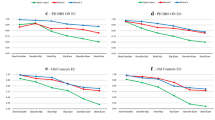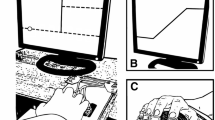Abstract
We aimed to quantify the effects of bilateral subthalamic nucleus (STN) stimulation in Parkinson's disease (PD) on stance and gait ("axial"motor control), and related this to effects on finger movements ("appendicular" motor control). Fourteen PD patients and 20 matched controls participated. Subjects completed several balance and gait tasks (standing with eyes open or closed, on a normal or foam surface; retropulsion test; walking with eyes closed; walking up and down stairs; Get Up and Go test). Postural control was quantified using trunk sway measurements (angle and angular velocity) in the roll and pitch directions. Subjects further performed a pinch grip reaction time task, where we measured isometric grip forces, as well as movement and reaction times. Patients were examined with STN stimulators switched on or off (order randomised across patients), always after a supramaximal levodopa dosage. STN stimulation improved postural control, as reflected by a reduced trunk sway tremor during stance, a reduced duration for all gait tasks, an increased trunk pitch velocity while rising from a chair, and improved roll stability. STN stimulation also improved finger control, as reflected by a reduced time to reach maximum grip force, without altering reaction times and maximum force levels. Improvements in finger control timing did not correlate with reduced task durations during gait. We conclude that STN stimulation affords improvement of postural control in PD, over and above optimal drug treatment. STN stimulation also provides a simultaneous effect on distal and axial motor control. Because improvements in distal and axial motor control were not correlated, we assume that these effects are mediated by stimulation of different structures within the STN.
Similar content being viewed by others
References
Koller WC, Glatt S, Vetere–Overfield B, Hassanein R (1989) Falls and Parkinson's disease. Clin Neuropharmacol 2:98–105
Bloem BR, Hausdorff JM, Visser JE, Giladi N (2004) Falls and freezing in Parkinson's disease: a review of two interconnected, episodic phenomena. Mov Disord 19:871–884
Nutt JG, Hammerstad JP, Gancher ST (1992) Parkinson's disease: 100 maxims. London: Edward Arnold
Bloem BR, Bhatia KP (2004) Gait and balance in basal ganglia disorders. In: Bronstein AM, Brandt T, Nutt JG, Woollacott MH (eds) Clinical Disorders of Balance, Posture and Gait. Arnold: London, pp 173–206
Lang AE, Lozano AM (1998) Parkinson's disease. Second of two parts. N Engl J Med 339:1130–1143
Damier P, Houeto JL, Bejjani BP, et al. (2001) The role of the pallidum in Parkinson's disease gait. Lessons from pallidal stimulation. Adv Neurol 87:283–288
Krack P, Poepping M, Weinert D, Schrader B, Deuschl G (2000) Thalamic, pallidal, or subthalamic surgery for Parkinson's disease? J Neurol 247(Suppl 2):II122–II134
Benabid AL, Benazzouz A, Hoffmann D, Limousin P, Krack P, Pollak P (1998) Long–term electrical inhibition of deep brain targets in movement disorders. Mov Disord 13(Suppl 3):119–125
Samii A, Nutt JG, Ransom BR (2004) Parkinson's disease. Lancet 363:1783–1793
The Deep–Brain Stimulation for Parkinson's Disease Study Group (2001) Deep–brain stimulation of the subthalamic nucleus or the pars interna of the globus pallidus in Parkinson's disease. N Engl J Med 345: 956–963
Welter ML, Houeto JL, Tezenas du MS, et al. (2002) Clinical predictive factors of subthalamic stimulation in Parkinson's disease. Brain 125:575–583
Bakker M, Esselink RA, Munneke M, Limousin–Dowsey P, Speelman JD, Bloem BR (2004) Effects of stereotactic neurosurgery on postural instability and gait in Parkinson's disease. Mov Disord 19:1092–1099
Bloem BR, Beckley DJ, van Hilten JJ, Roos RA (1998) Clinimetrics of postural instability in Parkinson's disease. J Neurol 245:669–673
Stolze H, Klebe S, Poepping M, et al. (2001) Effects of bilateral subthalamic nucleus stimulation on parkinsonian gait. Neurology 57:144–146
Maurer C, Mergner T, Xie J, Faist M, Pollak P, Lucking CH (2003) Effect of chronic bilateral subthalamic nucleus (STN) stimulation on postural control in Parkinson's disease. Brain 126:1146–1163
Faist M, Xie J, Kurz D, et al. (2001) Effect of bilateral subthalamic nucleus stimulation on gait in Parkinson's disease. Brain 124:1590–1600
Rocchi L, Chiari L, Horak FB (2002) Effects of deep brain stimulation and levodopa on postural sway in Parkinson's disease. J Neurol Neurosurg Psychiatry 73:267–274
Bronte–Stewart HM, Minn AY, Rodrigues K, Buckley EL, Nashner LM (2002) Postural instability in idiopathic Parkinson's disease: the role of medication and unilateral pallidotomy. Brain 125:2100–2114
Rocchi L, Chiari L, Cappello A, Gross A, Horak FB (2004) Comparison between subthalamic nucleus and globus pallidus internus stimulation for postural performance in Parkinson's disease. Gait Posture 19:172–183
Bloem BR, Visser JE, Allum JH (2003) Posturography. In: Hallett M (ed) Handbook of clinical neurophysiology. Amsterdam: Elsevier Science BV, pp 295–336
Gill J, Allum JH, Held–Ziolkowska M, Carpenter MG, Honegger F, Pierchala K (2001) Trunk sway measures of dynamic equilibrium during clinical balance tasks: effects of age. J Gerontol Med Sci 56:M438–M447
Allum JH, Adkin AL, Carpenter MG, Held–Ziolkowska M, Honegger F, Pierchala K (2001) Trunk sway measures of postural stability during clinical balance tests: effects of a unilateral vestibular deficit. Gait Posture 14:227–237
de Hoon EWJ, Allum JH, Carpenter MG, et al. (2003) Quantitative assessment of the "stops walking while talking test" in the elderly. Arch Phys Med Rehabil 84:832–842
Adkin AL, Allum JH, Bloem BR (2004) Stance and gait trunk sway test measurements to assess balance control in patients with Parkinson's disease. Gait Posture (in press)
Hughes AJ, Daniel SE, Kilford L, Lees AJ (1992) Accuracy of clinical diagnosis of idiopathic Parkinson's disease: a clinico–pathological study of 100 cases. J Neurol Neurosurg Psychiatry 55:181–184
Goetz CG, Stebbins GT, Shale HM, et al. (1994) Utility of an objective dyskinesia rating scale for Parkinson's disease: inter– and intrarater reliability assessment. Mov Disord 9:390–394
Kumar R, Lozano AM, Sime E, Halket E, Lang AE (1999) Comparative effects of unilateral and bilateral subthalamic nucleus deep brain stimulation. Neurology 53:561–566
Lang AE (1995) Clinical rating scales and videotape analysis. In: Koller WC, Paulson G (eds) Therapy of Parkinson's disease. New York:Marcel Dekker, pp 21–46
Tinetti ME (1986) Performance–oriented assessment of mobility problems in elderly patients. J Am Geriatr Soc 34:119–126
Powell LE, Myers AM (1995) The activities– specific balance confidence (ABC) scale. J Gerontol Med Sci 50A:M28–M34
Bloem BR, Grimbergen YA, Cramer M, Willemsen MD, Zwinderman AH (2001) Prospective assessment of falls in Parkinson's disease. J Neurol 248:950–958
Wenzelburger R, Zhang BR, Poepping M, et al. (2002) Dyskinesias and grip control in Parkinson's disease are normalized by chronic stimulation of the subthalamic nucleus. Ann Neurol 52:240–243
Wenzelburger R, Kopper F, Zhang BR, et al. (2003) Subthalamic nucleus stimulation for Parkinson's disease preferentially improves akinesia of proximal arm movements compared to finger movements. Mov Disord 18:1162–1169
Alberts JL, Elder CM, Okun MS, Vitek JL (2004) Comparison of pallidal and subthalamic stimulation on force control in patient's with Parkinson's disease. Motor Control 8:484–499
Berardelli A, Dick JPR, Rothwell JC, Day BL, Marsden CD (1986) Scaling of the size of the first agonist EMG burst during rapid wrist movements in patients with Parkinson's disease. J Neurol Neurosurg Psychiatry 49:1273–1279
Johnson MT, Mendez A, Kipnis AN, Silverstein P, Zwiebel F, Ebner TJ (1994) Acute effects of levodopa on wrist movement in Parkinson's disease. Kinematics, volitional EMG modulation and reflex amplitude modulation. Brain 117(Pt 6):1409–1422
Hermsdorfer J, Mai N, Marquardt C (1992) Evaluation of precision grip using pneumatically controlled loads. J Neurosci Methods 45:117–126
Visser M, Marinus H, Bloem BR, Kisjes H, van den Berg BM, van Hilten JJ (2003) Clinical tests for the evaluation of postural instability in patients with Parkinson's disease. Arch Phys Med Rehabil 84:1669–1674
Munhoz RP, Li JY, Kurtinecz M, et al. (2004) Evaluation of the pull test technique in assessing postural instability in Parkinson's disease. Neurology 62:125–127
Bloem BR, Roon KI, Delleman NJ, van Dijk JG, Roos RA (1997) Prolonged duration of standing up is an early dopa–sensitive abnormality in Parkinson's disease. J Neurol Sci 146:41–44
Nikfekr E, Kerr K, Attfield S, Playford ED (2002) Trunk movement in Parkinson's disease during rising from seated position. Mov Disord 17:274–282
Wasielewski PG, Burns JM, Koller WC (1998) Pharmacologic treatment of tremor. Mov Disord 13(Suppl 3):90–100
Krack P, Benazzouz A, Pollak P, et al. (1998) Treatment of tremor in Parkinson's disease by subthalamic nucleus stimulation. Mov Disord 13:907–914
Author information
Authors and Affiliations
Corresponding author
Rights and permissions
About this article
Cite this article
Vrancken, A.M.P.M., Allum, J.H.J., Peller, M. et al. Effect of bilateral subthalamic nucleus stimulation on balance and finger control in Parkinson's disease. J Neurol 252, 1487–1494 (2005). https://doi.org/10.1007/s00415-005-0896-7
Received:
Revised:
Accepted:
Published:
Issue Date:
DOI: https://doi.org/10.1007/s00415-005-0896-7




